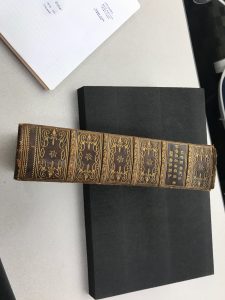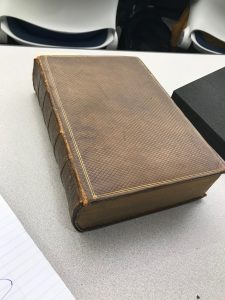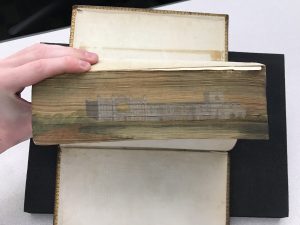Fore-edge painting might as well be black magic to the uneducated. Before this class, I had never heard of fore-edge painting before. I had seen many old leather bound books in my life, but never with a painting on the side. When presented with one in class, my mind was simply blown.
Of course, I am not a very big reader so what book I decided to take off the cart was purely random. I first looked at a white book dating back to 1791 in Paris. Upon my initial fan, I could feel the age of the book. The binding was weakened, the pages were stiff and not too malleable, and the painting was hard to see at first. After finding the right fold so to speak, the painting became clear as day. It was remarkable to see such a vivid castle on the side of a book. The book itself was not too special, besides the fact that it was over 200 years old.
The second book that I looked at was a little more intriguing. I am currently taking my second-level English writers course, and we happen to be reading books that were written in the 18th-19th century, right about the time when a lot of books seemed to have been painted with fore edge paintings. The most recent book we read was Manfred, which is actually a play but rather short. It is a product of Lord Byron, whose book I had just picked up in the library. An unbelievable coincidence I thought.
Although the entire book was not Manfred, but rather “the Political Works of Lord Byron”, it was unique nonetheless to see an original book of a subject I am studying separately. The book itself was in rather good condition. Stiff binding, pliable pages, and a very nice gold trim around the leather on the book. The fore-edge painting was another castle, cathedral or sanctuary. It is unclear at this moment what exactly the building is, perhaps after some more research I can figure out precisely what structure that is. The book dates to 1895, published in London by John Murray, Albemarle Street. It is number 32 in the Knott collection at the Notre Dame Loyola Library.
The book itself is about average size I would estimate, 5 inches by 7 maybe. Leather bound as I mentioned, which adds a very cool texture and look, especially as it has aged since its construction. Thankfully there are no curious smells accompanying the book other than age.
Although I do not know much about books, and we are continuing to learn more about fore-edge paintings, I think this book is a great start to a series of 3 books to be displayed. I enjoy the castle/building theme because it’s simple, and there is a good chance a lot of the books that share that painting are in some way related. Whether that is publisher, writer, genre, author, binder, or location, will be determined in the research to come. Also, because the book is to me an average size, I believe that will make it easier in a way to display simply because of its size. It is big enough that the painting is not microscopic and easy to see, but small enough that it could fit just about anywhere.
-Max



